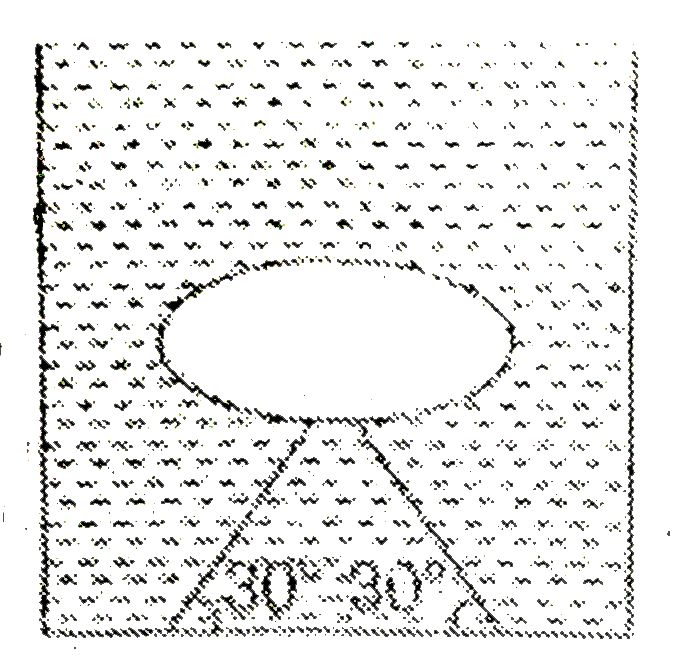An object is immersed in a fluid. In order that the object becomes invisible, it should
Behave as perfect reflector
absorb all light falling on it
Have refractive index one
Have refractive index exactly matching with that of thr surrounding fluid.
The correct Answer is:D
To solve the problem of making an object invisible when it is immersed in a fluid, we need to consider the concept of refractive index and how it affects light propagation.
1. Understanding Refractive Index:
- The refractive index (n) of a medium determines how much light bends when it enters that medium. It is defined as the ratio of the speed of light in vacuum to the speed of light in that medium.
2. Condition for Invisibility:
- An object becomes invisible when it does not cause any deviation of light passing through it. This occurs when the refractive index of the object (μ2) is equal to the refractive index of the surrounding fluid (μ1).
3. Setting the Condition:
- For the object to be invisible, we need the condition:
μ1=μ2
- This means that the light will pass through the object and the fluid without bending or reflecting, making the object indistinguishable from the fluid.
4. Conclusion:
- Therefore, the object should have a refractive index that exactly matches that of the surrounding fluid to become invisible.
Final Answer:
The object should have a refractive index exactly matching that of the surrounding fluid.
- The refractive index (n) of a medium determines how much light bends when it enters that medium. It is defined as the ratio of the speed of light in vacuum to the speed of light in that medium.
- An object becomes invisible when it does not cause any deviation of light passing through it. This occurs when the refractive index of the object (μ2) is equal to the refractive index of the surrounding fluid (μ1).
- For the object to be invisible, we need the condition:
μ1=μ2
- This means that the light will pass through the object and the fluid without bending or reflecting, making the object indistinguishable from the fluid.
- Therefore, the object should have a refractive index that exactly matches that of the surrounding fluid to become invisible.
The object should have a refractive index exactly matching that of the surrounding fluid.
Similar Questions
The chromosomes become invisible in
View SolutionBuoyant force on an object completely immersed in a fluid does not depend on the density of the object. It would only depend on the weight of liquid displaced. If the vessel in which an object is immersed is accelerated then the pseudo force acting on the object in the frame of the vessel depends on the mass of the object. The direction of motion of an object relative to a vessel can be found by finding the resultant of buoyant force, the pseudo force, the gravitational force and any other force acting on the body.
If in the previous problem the beaker was given a rightward acceleration then relative to the beaker the block will have a tendency to move :
View Solution
Knowledge Check
Assertion: If an object is submerged in fluid at rest, the fluid exerts a force on its surface.
Reason: The force exerted by the fluid at rest has to be parallel to the surface in contact with it.ABoth assertion and reason are true and reason is the correct explanation of assertion.BBoth assertion and reason are true but reason is not the correct explanation of assertion.CAssertion is true and reason is false.DBoth assertion and reason are false.
A hollow object of volume V is immersed in a tank. The object is tied to the bottom of the tank by two wires which make an angle 30∘ with the horizontal as shown in figure. The object would float if it was set free and one forth volume is immersed in liquid of density ρ0. The tension in the wires is

View SolutionA glass lens of refractive index 1.45 when immersed in a transparent liquid becomes invisible. Under what condition does it happen ?
View SolutionConsider an extended object immersed in water contained in a plane trough. When seen from close to the edge of the trough, the object looks distorted because.
View SolutionThe inertia of an object tends to cause the object
View SolutionAn object of mass m is floating in a liquid of density σ. If the object is made up of density ρ, then appare weight of the object in the liquid is
View SolutionReal and inverted image of an object is formed at a distance d=40 cm from the object. The size of the image is hall of that of object.

View SolutionTwo different object are completely immersed in water and undergo same loss in weight. Is it necessary that the weights of these objects in air be also the same?
View Solution
